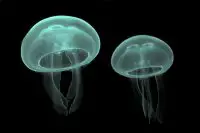Moon jellyfish (Aurelia Aurita) belongs to the genus Aurelia. The species from this genus are examined quite extensively. However, it is not easy to identify each one of these species separately since all of these bear close resemblance. Just like an immortal jellyfish, moon jellies are also found to leap back to the initial stage of their lifecycle and start their life all over again.
One of the distinguishing characteristics of these jellies is the presence of four prominent gonads that are shaped like horseshoes. Moon jellies do not have any organ for respiration, circulation and excretion. Instead, they breathe by getting oxygen with the help of a thin membrane. They do so by taking oxygen-rich water through a process called diffusion. They have a glass-like appearance. The tentacles are anchored to the base of the medusa (stomach).
The diameter of moon jellies is around 25 to 40 centimeters.
In the wild, moon jellies have a lifespan of not more than 6 months probably due to diseases. However, in public aquariums, they may live on for many years.
The species  from this genus are widely distributed across the temperate waters of the northern areas of Europe and America. They are present off the eastern and western shores of the Atlantic Ocean.
from this genus are widely distributed across the temperate waters of the northern areas of Europe and America. They are present off the eastern and western shores of the Atlantic Ocean.
These jellies inhabit inshore river mouths and harbors.
Moon jellies mainly feed on small crustaceans, plankton and mollusks. They are found to eat larvae of tunicate, fish eggs, wheel animals, young bristle worms and protozoans. Apart from these, they may also eat comb jellies. By means of their tentacles, they carry the food inside their bodies to digest them.
Moon jellies have many predators like leathery turtle, common mola, fried egg jellyfish and crystal jelly. The sea birds also prey upon these jellies.
Other Names: Saucer jelly, Common jellyfish





